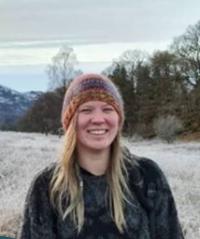Cohort 5
 Axa-Maria Lääperi
Axa-Maria Lääperi
- One Planet DTP Researcher School of Mathematics, Statistics and Physics
- Email: a.laaperi2@newcastle.ac.uk
- Based at: Newcastle University
Project Title:
Climate change effects on the spread of wildfires: A mathematical approach
Bio:
Throughout most of my waking hours, I would prefer to be atop a snowy mountain, amidst a forest, or cycling. Originating from Finland, a country where approximately 80% of the land is covered by lakes and forests, it’s unsurprising that I have a dedication to preserving natural landscapes.
While deliberating my career direction, I thoroughly enjoyed working in the forestry and horticultural industries. Opting for mathematical biology proved to be a well-suited choice, as it amalgamates my interests in nature and mathematics.
Now focusing on mathematically modelling ecological systems and the effects of climate change, I’m excited to be contributing towards the knowledge, understanding and innovation of forest health.
Supervisors:
- Dr Laura Wadkin, Newcastle University
- Prof Nick Parker, Newcastle University
- Dr Andrew Baggaley, Newcastle University
- Dr Yao Liu, Northumbria University
Research Aims:
- To improve theoretical knowledge of wildfire spread through physical-based complex system models
- To model and simulate wildfire spread and its interactions with atmospheric conditions, topography and vegetation types
- To infer model parameters and validate results from real fire event data of the UK
- To use the model to determine management and prevention strategies for wildfires and effects of global climate change
Techniques:
Wildfires are a disturbance to a variety of ecosystems, and vulnerability is likely to increase in areas which are not adapted to these disturbances due to climate change. The occurrence of wildfires requires the influence of several factors, since these dynamics tend to be affected by abrupt shifts in environment, even small changes in the drivers can cause large changes in the system - making predictions difficult. Mathematical models can theoretically aid to find thresholds for spread and predict how abrupt shifts in drivers are affecting overall burnt areas and the rate of spread. For such multi-scale, spatio-temporal systems we employ complex system modelling approaches which aim to illustrate the dynamic behaviour of fire and it’s interactions with the environment. This involves using a combination of mathematical, statistical and computational techniques for close to real-time simulations to be of use in emergency situations.
Due to recent events, the vulnerability of the UK with regard to wildfire events has raised awareness and highlighted the potential for environmental damage and loss of property and key infrastructure. Most UK wildfires are a result of inadvertent or deliberate human action, but the environmental conditions depend on antecedent and current weather. With the use of Geographic Information Systems, meteorological data, and real fire event data from the Global Wildfire Information System, the Department for Environment, Food and Rural Affairs, local drone footage collected from moorland heather burning season and modern statistical techniques, such as Bayesian history matching, we can validate the model by testing its ability to predict unseen data and infer parameters. Thus, the model can then be used to predict future events, improve management strategies and aid decisions on climate change effects such as outlying weather patterns that may influence fire behaviour
Education:
University of St Andrews - MSc Mathematical Biology (2022-2023)
University of Glasgow - BSc Mathematics (2014-2018)
Skills
- Python, Matlab and R
- Mathematical Modelling
- Data Analysis








